[WATCH] Tunnel proposed beneath Regional Road in plan to turn Paceville into prime coastal location
High-rise coastal location will see works on a tunnel passing beneath Regional Road start in 2018, as part of a €300 million project intended to breathe new life into the area.


The Planning Authority has opened a public consultation process for a new development framework for Paceville to assess the merits of development in the context of public services, infrastructure and the built environment, residents, and neighbouring localities.
The plan was developed by international infrastructure and planning experts Mott MacDonald and Broadway Malyan.
Parliamentary Secretary for planning Deborah Schembri said Malta had seen unprecedented economic growth in the last years, bringing with it new challenges.
“We must look at the bigger picture and adopt a holistic approach where quality of life and social well-being are at par with economic progress. Malta is in the right place and in time to make a shift change in the way things are done.”

PA chairman Johann Buttigieg said the potential surge in Paceville’s urban development had seen a growing number of businesses establish themselves locally, attracting an increase in visitors and residents.
But this also meant providing an integrated approach to achieve sustainable economic growth, and provide residents of Paceville and the surrounding areas with an attractive place to live, work and shop.
“We see this plan as critical to realising our vision for Paceville, creating Malta’s prime coastal location. In the longer term, we expect this integrated planning framework to form the basis of all future planning in Malta.”
The masterplan identifies the area for new high-rise development, together with a new tunnel running Regional Road after 2018 and a larger beach.
In the proposals, St George’s beach is to be enlarged and traffic management to be prioritised.

Damian Price from Mott McDonald gave a detailed background to the project. Poor quality arrival points and bad aesthetic were the first impressions at Paceville that needed to first be addressed, he said,
One of the key issued is the dominance of car traffic that causes challenges to pedestrians and cyclists and was not helped by poor quality public realm and street environment. “We want to make it an attractive and enticing area,” Price said.
The impact of new high-rise towers on the skyline would not be visible from the area Fort Ricasoli, according to the proposed model.
Price said that it is estimated that the project would support 9,000 jobs, raise property prices in the surrounding areas and cause a decrease in antisocial behaviour.
The plan focuses on improving the first impression on arrival into Paceville, the quality of the key destination spaces and the preservation and improvement of existing heritage and open space assets. A combined transport strategy was proposed to establish a connected network of transport options to the public space and pedestrian permeability while improving circulation and providing improved access to the waterfront.
The parking and transport solutions recommended are also intended to help to remove a proportion of the traffic, deliver improvements to the streetscape through the widening of pavements for pedestrians, improved landscaping and opportunities for other forms of sustainable transport, such as cycling.
Separate to this masterplan, Transport Malta has commissioned the construction of the Regional Road tunnel which is expected to divert as much as 60% of traffic from the Paceville area.
Paceville’s utilities and infrastructure require upgrading to adequately provide the basis for the area’s future urban growth and its sustainability. The plan identifies the needs of Paceville across water, power, telecommunications and waste.
"The need to provide the brand and an image for Paceville, quality offices and an iconic skyline means that many of the key development sites will need to contain tall buildings but care has been taken in order to craft a coordinated and meaningful skyline as opposed to a scattered, unplanned approach. As a result, the approach to developing Paceville’s future skyline has been based on a number of factors, including the view from Valletta, reflecting the natural gradient which runs down to the seafront and maximising views out to sea."
The proposed project is divided into 3 phases:
-
Phase 0: Planned for 2017, this phase involves the construction of a continuous coastal path, new marine links to Paceville and an increase in open spaces.
-
Phase 1: 2017-18 includes parking management and establishing a shared space in the heart of Paceville. Wider resident parking zones and further sections of the coastal path will be implemented.
-
Phase 2: 2018-2021 The construction of the regional road tunnel.
-
Phase 3: 2021 onwards will include an upgraded main road circuit removing on street parking and adding cycle routes. Bus stops within 5 minute walk of all new developments. Much of the public spaces and the central plaza will be built in this phase.
The infrastructural costs of this project are expected to reach 300 million. Part of the funding would come from the EU and part of it would be funded by the private-sector on a per-square-metre basis. Developers would be asked to contribute and the current capping of the application fee at € 0.5 million would be removed. There was no indication as to how much taxpayer money would be involved.
This plan, which will override all the other plans currently in place, is still in the preliminary stages and all impact studies are still to be carried out.
Parliamentary Secretary for Planning Deborah Schembri said the plan created a good mix for the area and creates open spaces for the public.
“We want to make an iconic skyline...that is sustainable and respects historical sites that are currently lost in the jumble of buildings that we see today.”
The consultation period will end on 4 November 2016.








.jpg)




.jpg)






.png)

